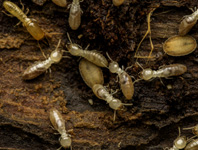Abstract
Foam-nesting frogs of the genus Physalaemus Fitzinger, 1826 have been long known for their diverse acoustic patterns (e.g., Barrio 1965; Bokermann 1966). Of the 49 species, the vocalizations of only three remain unknown to date (see Table 1 of Hepp & Pombal 2020): P. caete Pombal & Madureira, 1997, P. deimaticus Sazima & Caramaschi, 1988, and P. insperatus Cruz, Cassini & Caramaschi, 2008. Physalaemus caete is rare and narrowly distributed in Brazil’s northern Atlantic Forest (Santos et al. 2016; Bernardo et al. 2017; Haddad et al. 2018), and an explosive breeder (EMS pers. obs.). For those reasons the species is classified in the endangered category of Brazil’s red list of threatened species (ICMBio, 2018). Physalaemus caete was described in the late 1990s from the coastal region of the Brazilian state of Alagoas (Passo do Camaragibe) and reported for a second locality in Alagoas (Murici; Pombal & Madureira 1997). Recently, the distribution was extended to a third locality (Paulista, state of Pernambuco; Santos et al. 2016). The distribution range of P. caete coincides with the “Pernambuco endemism center”, a biogeographic subregion of coastal Atlantic Forest north of the São Francisco River (sensu Silva & Casteli 2003). Here we describe the advertisement call of the Pernambuco population of P. caete and make comparisons with calls of congeners.
References
Barrio, A. (1965) El género Physalaemus (Anura, Leptodactylidae) en la Argentina. Physis, 25, 421–444.
Bernardo, V.N., Pereira, E.N. & Santos, E.M. (2017) Anfíbios da Estação Ecológica de Caetés Paulista, Pernambuco: atualização da lista de espécies. Revista de Ciências Ambientais, 11, 39–49.
https://doi.org/10.18316/rca.v11i2.3003
Bokermann, W.C.A. (1966) Notas sobre três espécies de Physalaemus de Maracás, Bahia (Amphibia, Leptodactylidae). Revista Brasileira de Biologia, 26, 253–259.
Cassini, C.S., Taucce, P.P.G., Carvalho, T.R., Fouquet, A., Solé, M., Haddad, C.F.B. & Garcia, P.C.A. (2020) One step beyond a broad phylogenetic analysis: species delimitation of Adenomera marmorata Steindachner, 1867 (Anura: Leptodactylidae). Plos One, 15, e0229324.
https://doi.org/10.1371/journal.pone.0229324
Costa, T.R.N. & Toledo, L.F. (2013) Physalaemus spiniger (Anura: Leiuperinae): a frog with an extensive vocal repertoire. Journal of Herpetology, 47, 530–538.
https://doi.org/10.1670/12-083
Cruz, C.A.G., Cassini, C.S. & Caramaschi, U. (2008) A new species of the genus Physalaemus Fitzinger, 1826 (Anura, Leiuperidae) from southern Brazil. South American Journal of Herpetology, 3, 239–243.
https://doi.org/10.2994/1808-9798-3.3.239
Fitzinger, L.J. (1826) Neue Classification der Reptilien nach ihren Natürlichen Verwandtschaften nebst einer Verwandtschafts-Tafel und einem Verzeichnisse der Reptilien-Sammlung des K. K. Zoologisch Museum’s zu Wien. J. G. Heubner, Vienna, 66 pp.
https://doi.org/10.5962/bhl.title.4683
Gridi-Papp, M. (2007) SoundRuler: acoustic analysis for research and teaching. Available from: http://soundruler.sourceforge.net (accessed 5 May 2018)
Gridi-Papp, M. (2008) The structure of vocal sounds produced with the mouth closed or with the mouth open in treefrogs. Journal of the Acoustical Society of America, 123, 2895–2902.
https://doi.org/10.1121/1.2897001
Haddad, C.F.B., Machado, I.F., Giovanelli, J.G.R., Bataus, Y.S.L., Uhlig, V.M., Batista, F.R.Q., Cruz, C.A.G., Conte, C.E., Zank, C., Strüssmann, C., Canedo, C.C., Loebmann, D., Silvano, D.L., Nomura, F., Pinto, H.B.A., Amaral, I.B., Gasparini, J.L.R., Nascimento, L.B., Martins, M.R.C., Napoli, M.F., Gordo, M., Hoogmoed, M.S., Kienle, M.S., Maciel, N.M., Valdujo, P.H., Garcia, P.C.A., Sawaya, R.J., Lingnau, R., Bastos, R.P. & Caramaschi, U. (2018) Physalaemus caete. In: Instituto Chico Mendes de Conservação da Biodiversidade (Org.), Livro Vermelho da Fauna Brasileira Ameaçada de Extinção. Vol.5. Anfíbios. ICMBio/MMA, Brasília, D.F., pp. 95–97.
Hepp, F. & Pombal Jr., J.P. (2020) Review of bioacoustical traits in the genus Physalaemus Fitzinger, 1826 (Anura: Leptodactylidae: Leiuperinae). Zootaxa, 4725 (1), 1–106.
https://doi.org/10.11646/zootaxa.4725.1.1
Instituto Chico Mendes de Conservação da Biodiversidade (2018) Livro Vermelho da Fauna Brasileira Ameaçada de Extinção. ICMBio/MMA, Brasília, D.F., 4162 pp.
Ligges, U., Krey, S., Mersmann, O. & Schnackenberg, S. (2017) tuneR: analysis of music and speech. Available from: https://CRAN.R-project.org/package=tuneR (accessed 20 September 2018)
Lourenço, L.B., Targueta, C.P., Baldo, D., Nascimento, J., Garcia, P.C.A., Andrade, G.V., Haddad, C.F.B. & Recco-Pimentel, S.M. (2015) Phylogeny of frogs from the genus Physalaemus (Anura, Leptodactylidae) inferred from mitochondrial and nuclear gene sequences. Molecular Phylogenetics and Evolution, 92, 204–216.
https://doi.org/10.1016/j.ympev.2015.06.011
Matlab (2004) The language of technical computing. Version 6.5.2. MathWorks, Inc., Natick. [program]
Nascimento, L.B., Caramaschi, U. & Cruz, C.A.G. (2005) Taxonomic review of the species groups of Physalaemus Fitzinger, 1826, with the revalidation of the genera Engystomops Jimenez de la Espada, 1872 and Eupemphix Steindachner, 1836 (Amphibia, Anura, Leptodactylidae). Arquivos do Museu Nacional, Rio de Janeiro, 63, 297–320.
Pombal Jr., J.P. & Madureira, C.A. (1997) A new species of Physalaemus (Anura, Leptodactylidae) from the Atlantic rain forest of northeastern Brazil. Alytes, 15, 105–112.
Purgue, A.P. (1995) The sound broadcasting system of the bullfrog (Rana catesbeiana). Ph.D. thesis, The University of Utah, Salt Lake City, Utah.
R Core Team (2018) R: a language and environment for statistical computing, version 3.5.0. R Foundation for Statistical Computing, Vienna. Available from http://www.r-project.org (accessed 5 May 2018)
Santos, E.M., Nacimento, V., Pereira, E.N. & Amorim, F.O. (2006) Physalaemus caete. Herpetological Review, 47, 249.
Sazima, I. & Caramaschi, U. (1988) Descrição de Physalaemus deimaticus sp. n., observações sobre comportamento deimático em P. nattereri (Steindn.) – Anura. Revista de Biologia, Lisboa, 13, 91–101.
Silva, J.M.C. & Casteleti, C.H.M. (2003) Status of the biodiversity of the Atlantic Forest of Brazil. In: Galindo-Leal C. & Câmara, I.G. (Eds.), The Atlantic Forest of South America: Biodiversity, Threats, and Outlook. Island Press, Washington, D.C., pp. 43–59.
Sueur, J., Aubin, T. & Simonis, C. (2008) Seewave: a free modular tool for sound analysis and synthesis. Bioacoustics, 18, 213–226.
https://doi.org/10.1080/09524622.2008.9753600


